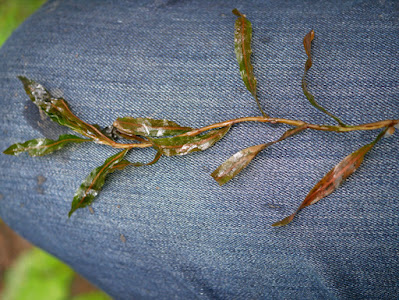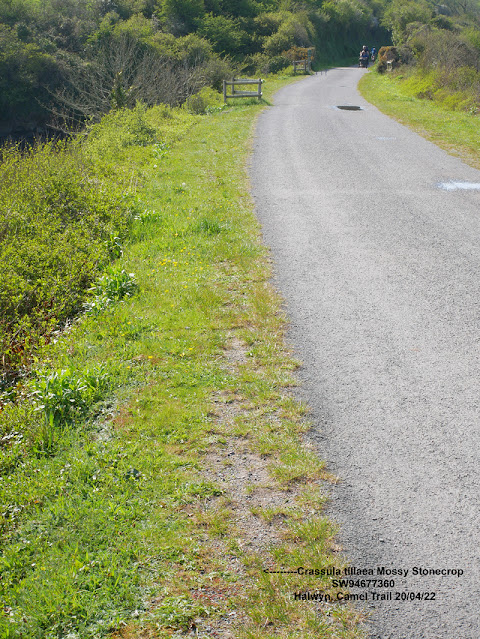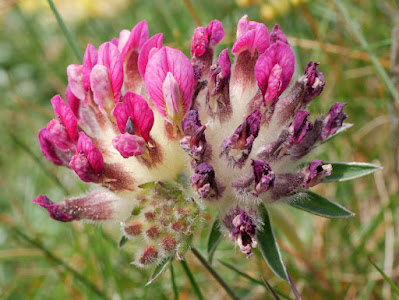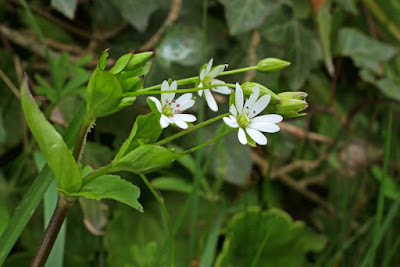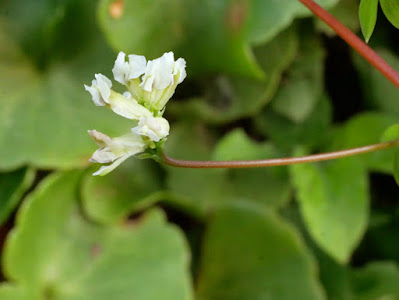As April comes to a close, it's still quite chilly, so the Summer species haven't as yet put in much of an appearance. However, there is still plenty to see, and this blog features the more interesting plants found in the last week of April here.
Tiny yellow dots in the grass at Tregonetha Downs alerted me to the smallest tree I'd ever seen, the Creeping Willow. It's only a few inches tall and snaked between grasses, hugging the ground. If it weren't in flower, I wouldn't have noticed it at all.
Here are the male flowers carrying pollen.
And the female flowers awaiting pollen to arrive in the wind.
Salix repens
Here, I have down my eye loupe down to show some scale.
Heath Milkwort was also in the grasses. Mostly blue, but I did spot one white and another pink form. These are always smaller in form and flowers than Common Milkwort, but the only way to be totally sure is to look at the lower stem. Here you will find opposite leaves (or leaf scars if they've fallen off) in Heath Milkwort. But in Common Milkwort, they will all be alternate.
Polygala serpyllifolia
 | ||||||||||||||||||
This week, I also found two new pondweeds I'd not seen before, but seem fairly common here. The first was Bog Pondweed which has narrow leaves that aren't transluscent and stems without any form of hinge near where the leaf blade surfaces.
Bog Stitchworts put in an appearance at several venues too. It's a very small flower and hard to spot. It can be confused with Common Chickweed, Thyme Leaved Sandwort or Annual Pearlwort, so take care in looking at different features to identify it. The opposite paired leaves,square hairless stems and heavily bifid petals cut right to the base identify this one from the lookalikes.
Stellaria alsine
 |
It was nice to find a native white Bluebell. These are much more common in Kent than here. In fact, this is one of only three I've seen here.
Hyacinthoides non-scripta
Of course, I notice insects along the way, and you can't not notice a large black beetle bumbling around clumsily. This one was a Bloody-nosed Beetle which when threatened, it secretes a distasteful blood-red liquid from its
mouth. This flightless beetle can be found on grassland and heathland,
and along hedgerows, as here.
Bloody-nosed beetle - Timarcha tenebricosa
There are just as many Cuckooflowers in Cornwall as there were in Kent, however, they are usually much smaller. Most are under a foot tall, but they still look great. This one below was taken in the evening light, so the gentle pastel colours haven't been bleached out by a harsh sun.
Cardamine pratensis
One area which was in a disused small quarry, had numerous spikes of Common Gromwell, a few in flower too. Rare in Cornwall.
Lithospermum officinale
Below: Behind it is last year's plant, still adorned with the tiny ivory like seeds.
Some evening views of the tidal River Camel saltmarsh.
Yellow Iris (sometimes called Yellow Flag) is abundant here and some were coming into flower now.
Iris pseudacorus
Flowering Redcurrants are my last offering for April. Weird looking flowers that turn into bunches of bright red edible berries. Although common in Kent, I rarely saw them in flower, whereas here, I've now seen plenty of them flowering.
Ribes rubrum
So ended April. As we enter May, the weather is still cool and breezy, though we did have two quite warm days, and the plants are now responding. There will be an explosion of wildflowers soon and I hope to see as much of it as I can.
Take care
Dave
Twitter: @botany2021






